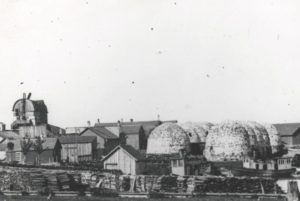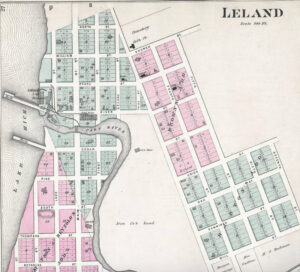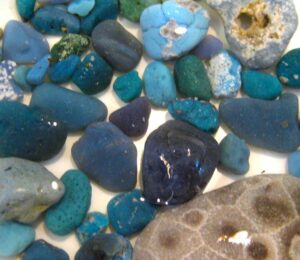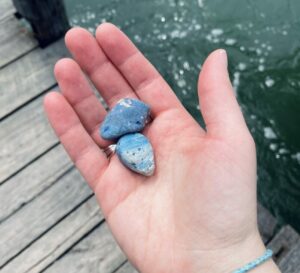
Leland Iron Works
Leland became the Lake Michigan port for an iron smelting furnace in 1870. Chosen for its proximity to the iron port of Escanaba and abundance of hardwood, the region altered drastically during the construction of the new furnace. As workers flooded the area, the village of Leland needed to expand in order to accommodate the growing population. Leland Iron Works was overseen by four different corporations from 1870 to 1885, each ultimately running into financial issues. While there were high hopes for its success, the staggering operational costs in combination with the lack of a suitable harbor in Leland became the source of the Iron Works premature downfall. During operations, the iron smelting furnace burned charcoal to smelt iron ore. The smelting process created a waste product called slag, better known today as Leland Blue Stone.

In 1881 Leland’s riverfront was dominated by an iron foundry, which operated from 1870-1885.
Mined iron ore consists of iron and oxygen. To remove the oxygen, a chemical reaction must take place. Charcoal is burned producing heat, allowing the carbon within it to combine with the oxygen from the ore to produce carbon dioxide, leaving the desired iron free. Limestone was used as a flux in the smelting process to combine with the impurities within the ore. Along with heat, this would produce liquid slag and it would flow off the iron as a waste product. This waste product solidified into Leland Blue, a beloved stone characteristic to the Leland area. The slag, deemed worthless back in its day of production, was unceremoniously used as landfill and dumped into Lake Michigan, gradually returning to the shore over the years on local beaches.
![]()
![]()
![]()
Locals and visitors alike comb the area beaches in the hopes of finding rocks in a striking shade of blue throughout all seasons of the year. The stones are found in various shapes and sizes, often pockmarked and full of crevices left behind from the cooling process. While blue shades are the most common, they can also be gray, green, and even purple. Fragments of history, Leland Blue Stones are a reminder of what the Leelanau landscape used to hold, and representative of the beauty that can surface with time.


